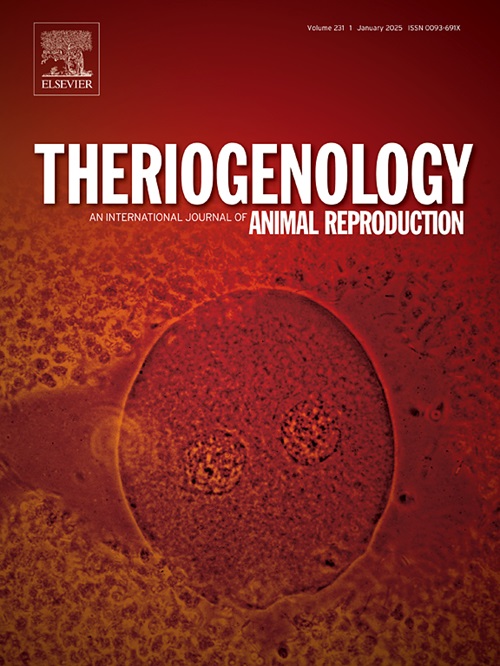妊娠、热应激和补充炔雌素对猪黄体中期黄体蛋白质组的影响
IF 2.4
2区 农林科学
Q3 REPRODUCTIVE BIOLOGY
引用次数: 0
摘要
功能性黄体(CL)是猪建立和维持妊娠所必需的。由于热应激(HS)导致怀孕和生殖周期中断,给养猪业造成了巨大的经济损失。本研究的目的是表征早期妊娠建立的CL蛋白质组,并确定妊娠建立期间受HS和alt - noest补充影响的差异丰富蛋白。在同步和发情检测之后,将41头后备母猪分配到六个治疗组中的一个,以便比较妊娠(循环(C)或妊娠(P))、热环境(热中性(TN)或HS)的影响,以及妊娠后备母猪补充15 mg/d (ALT)或不补充(CON)的影响。母猪在发情后2天(dpe)进行热处理,并开始补充ALT。在12dpe时,对动物实施安乐死,从每头母猪收集CL (n = 3-4),提取蛋白质,并进行无标签液相色谱-串联质谱(LC-MS/MS)。两个独立的分析,一个关注妊娠和环境的影响,另一个关注环境和ALT补充的影响,分别确定了1470和907个差异丰富的蛋白质。治疗之间的差异表明,妊娠、HS和ALT的补充会以可能影响CL功能和消退的方式改变CL蛋白质组。这些蛋白包括参与氧化还原酶活性(SOD1)、翻译和核糖体活性以及金属离子结合(PGMRC1和CYCS)的蛋白。了解这些影响有助于提高猪的繁殖性能。本文章由计算机程序翻译,如有差异,请以英文原文为准。
The effect of pregnancy, heat stress and altrenogest supplementation on the porcine mid-luteal phase corpus luteum proteome
Functioning corpora lutea (CL) are required for establishment and maintenance of pregnancy in pigs. Disruptions of pregnancy and reproductive cyclicity due to heat stress (HS) result in substantial economic losses for the swine industry. The objectives of this study were to characterize the CL proteome during early pregnancy establishment, and identify differentially abundant proteins during pregnancy establishment affected by HS and altrenogest supplementation. Following synchronization and estrus detection, gilts (n = 41) were assigned to one of six treatment groups enabling comparisons to evaluate the effects of pregnancy (cyclic (C) or pregnant (P)), thermal environment (thermal neutral (TN) or HS), and within pregnant gilts, supplementation with altrenogest 15 mg/d (ALT) or without (CON). Gilts were exposed to the thermal treatment at 2 days post estrus (dpe) and began receiving ALT supplementation 3dpe. At 12dpe, animals were euthanized, CL (n = 3–4) from each gilt were collected, protein extracted, and subjected to label free liquid chromatography - tandem mass spectrometry (LC-MS/MS). Two separate analyses, one focused on the effect of pregnancy and environment, and the other on the effect of environment and ALT supplementation, were conducted that identified 1470 and 907 differentially abundant proteins, respectively. Differences between treatments identified that pregnancy, HS and ALT supplementation alter the CL proteome in ways that may influence CL function and regression. These included proteins involved in oxidoreductase activity (SOD1), translation and ribosomal activity, and metal ion binding (PGMRC1 and CYCS). An understanding of these effects could help improve reproductive performance in swine production.
求助全文
通过发布文献求助,成功后即可免费获取论文全文。
去求助
来源期刊

Theriogenology
农林科学-生殖生物学
CiteScore
5.50
自引率
14.30%
发文量
387
审稿时长
72 days
期刊介绍:
Theriogenology provides an international forum for researchers, clinicians, and industry professionals in animal reproductive biology. This acclaimed journal publishes articles on a wide range of topics in reproductive and developmental biology, of domestic mammal, avian, and aquatic species as well as wild species which are the object of veterinary care in research or conservation programs.
 求助内容:
求助内容: 应助结果提醒方式:
应助结果提醒方式:


